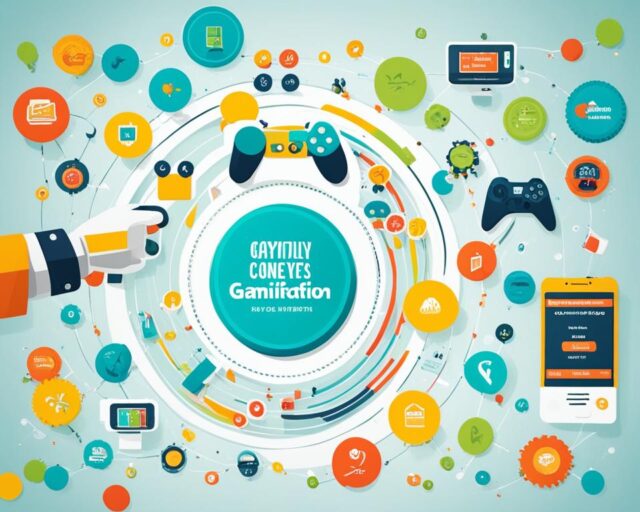Brame: Turn Your Marketing Interactive with Fun Games!
Looking for new ways to connect with your customers? We've got you covered! Meet Brame, a gamification platform designed to make your marketing strategies more engaging. It helps you create interactive games that grab your audience's attention and produce real results.
Brame gives you many options to make your customers more engaged. It helps make your brand more known and brings in good leads. The platform is easy to use with its customizable templates, so you don't need to know coding or design.
Why is Brame different from other gamification platforms? What makes it a game-changer for your marketing efforts? Explore the benefits of interactive content, increasing brand awareness, and gathering data with Brame. It's time to see how Brame can transform your marketing approach!
The Benefits of Gamification in Marketing
Gamification in marketing brings many benefits to businesses. It uses interactive games to make marketing fun and engaging. This helps get customers excited, leading to more sales and loyalty.
One key advantage is boosting customer engagement. Games with scores and competition make marketing immersive. This draws customers in, making them more likely to stick around and enjoy the experience.

Driving Engagement and Analyzing Results
With gamification, businesses can collect important data. They use tools to see what customers like in real time. This lets them make their marketing even better.
“Gamification provides marketers with data-driven insights to optimize their campaigns in real-time.” – Marketing Expert
Gamification also helps in the long run. It makes loyalty programs more exciting. Customers get rewarded, which keeps them coming back for more.
It's great for making people aware of your brand, too. Fun games create experiences people remember. They're more likely to talk about your brand, helping it reach more people.
Gamification turns marketing into an enjoyable adventure. It boosts engagement, helps adjust strategies, and keeps customers loyal. Businesses stand out by offering something truly engaging.
How Gamification Can Improve Customer Engagement
Gamification helps businesses make customer experiences more engaging and interactive. It uses game elements in marketing to grab attention and make brands memorable. This approach makes marketing campaigns stand out.
Marketers create challenges, competitions, and rewards that draw people in. These elements keep customers interested longer. It's about adding fun to the interaction.
Gamification motivates customers to take action, like buying or giving feedback. They earn points or badges for these actions. This makes customers more willing to engage with the brand.
It also makes customers feel like they're part of the adventure. They're not just watching; they're involved. This deep involvement boosts engagement and brand love.
“Gamified experiences offer a fun, interactive way to connect with a brand,” states Sarah Thompson from XYZ Agency. “It combines game elements and interactivity for a memorable, enjoyable brand experience.”
Also, gamification helps collect important data about the audience. Marketers learn about customer behaviors and preferences. This information helps improve marketing strategies and makes campaigns more effective.
“Gamification engages customers and collects valuable insights for future strategy,” says John Davis from ABC Company. “Seeing how customers respond helps customize messages and rewards for better engagement.”
Creating an Immersive User Experience
Good gamification focuses on user experience. It should be smooth, fun, and match the brand. Marketers aim to make everything look good and easy to use.
Adding gamification makes customers enjoy and talk about the brand. They remember positive experiences more. This leads to more people knowing about the brand.
Adding quizzes and polls makes experiences even more engaging. Customers get to show what they know and think. It's a deeper level of participation.
In summary, gamification boosts customer engagement. By making experiences fun and interactive, businesses keep customers’ attention longer. This leads to stronger brand connections and more actions from customers.
The Evolution of Marketing Strategies: From Mass to Direct to Data-Driven Marketing
Marketing has changed a lot over time. This is because of changes in what consumers want and new technology. We've moved from mass marketing to direct marketing, and now, to data-driven marketing. Each type has its own special features and pluses.
The Era of Mass Marketing
In the past, mass marketing was the main way to go. Companies would use TV ads, magazines, and billboards to reach everyone. They wanted to make their brand known to as many people as possible. But this way was not very personal and didn't always speak directly to people. So, it didn't always lead to sales or get customers involved.
The Rise of Direct Marketing
Then, as people started wanting different things, businesses began to use direct marketing. This method talked to specific groups of people and aimed to increase sales. Through things like mail, companies sent special offers right to people's homes. Direct marketing got more attention and better results. Yet, it was hard to reach a lot of people all at once.
The Shift to Data-Driven Marketing
Digital marketing and better data analysis started the data-driven marketing era. This way uses customer information to make ads that really speak to each person. It tries to understand what customers do and like to make better marketing plans.
Digital tools like social media and websites let businesses see what customers do right away. They can make ads that fit each person better. And, data-driven marketing is all about making sure customers enjoy their experience from start to finish.
The Power of Data-Driven Marketing
Data-driven marketing lets companies make choices based on what they really know about their customers. Knowing what customers like helps make ads that really connect. This builds trust and makes customers happier.
This kind of marketing also makes it easier to get more sales. By looking at data, marketers find ways to get better. This means they spend their money more wisely and get more back from their investment.
To wrap up, marketing has come a long way from mass to direct, and now to data-driven marketing. This shows how customer wants and technology have changed. Data-driven marketing gives companies what they need to offer personal experiences, get customers more involved, and increase sales. Staying up-to-date with data-driven marketing keeps businesses in the lead in today's digital age.
The Power of Gamification in Digital Marketing
Gamification changes the game in digital marketing. It makes campaigns interactive and fun. This draws customers in and leaves a lasting impression. Marketers use game elements to get customers to act. This boosts campaign success.
Gamification lets marketers collect important data. They add game-like parts to strategies and learn about their audience. This help makes their plans better and boosts marketing results. This approach helps businesses to be smarter in their choices.
“Gamification enhances customer engagement by providing a more immersive and enjoyable user experience.”
Gamification also builds loyalty and makes a brand stand out. It offers a one-of-a-kind brand experience. This can make customers more loyal. Plus, it makes your brand more known by linking positive feelings to the customer's experience.
To visually illustrate the power of gamification in digital marketing:
Boosting Customer Engagement
Gamification brings fun and excitement. It grabs customer attention and keeps them interested. It makes them want to interact more and connect with the brand.
Fostering Positive User Experience
Gamification makes users feel part of the brand. This makes the customer experience better. It leads to more engagement and a stronger connection with the brand.
Collecting Valuable User Data
It helps collect info on what customers like. Marketers use this data to make their strategies better. They tailor experiences to what customers want, leading to success.
Driving Meaningful Interactions
Gamification creates engaging experiences. It uses scores, competition, and rewards to get users to join in. This leads to more conversions and interactions that matter.
Gamification in digital marketing does a lot. It boosts customer engagement, experience, and helps collect data. By using this strategy, businesses can make their marketing better. They can stand out and keep customers loyal in a competitive digital world.
How to Successfully Implement Gamification in Marketing Campaigns
To use gamification in marketing well, you need a solid plan. Start by clearly defining their goals and objectives for the game-like experience. Knowing what they aim to achieve helps them create campaigns that engage customers and get good results.
It’s crucial to pick game concepts and templates that fit the campaign's goals and audience. Marketers need to think about what their audience likes. This makes the game experience interesting and gets more people to join in.
Being able to customize is key to success. Marketers need to adapt the game layout, branding, and rules to fit their brand. This makes the game blend well with their overall marketing, helping people recognize the brand.
Using social media helps promote game-based marketing. Marketers can use it to get people excited about their campaigns. This takes advantage of social media’s reach to create excitement and competition.
Tracking results in real-time is very important. By measuring the effectiveness of the campaign, marketers can see how well it's doing. They get useful info to make the gamified experience even better in the future.
For gamification to work well, keep improving it. By looking at what users do and say, marketers can see what needs to get better. This ongoing process helps increase participation, improve results, and build customer loyalty.
Conclusion
Gamification is changing marketing in big ways. It lets businesses make fun and engaging experiences. Businesses use game elements to boost their brand, keep customers coming back, and get useful data. With tools like Brame, creating these experiences is easy, even without coding or design skills.
As more people play online games and explore virtual worlds, gamification gets more important. Marketers can make their campaigns exciting by turning them into games. This method helps hold the audience's attention and get better results.
Marketing with gamification goes beyond usual methods. It lets companies interact with customers in fun ways. By making campaigns entertaining and rewarding, companies grab their audience's attention. This approach leads to more customer interaction, loyalty, and success in their marketing efforts.













